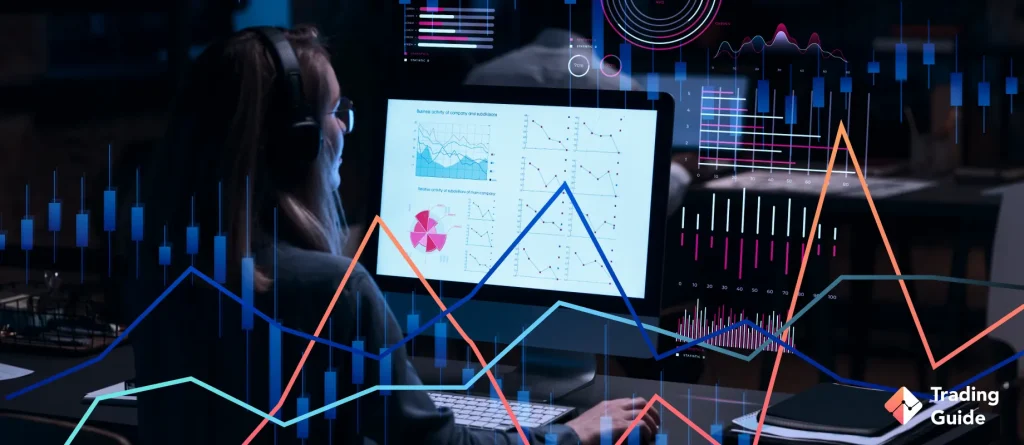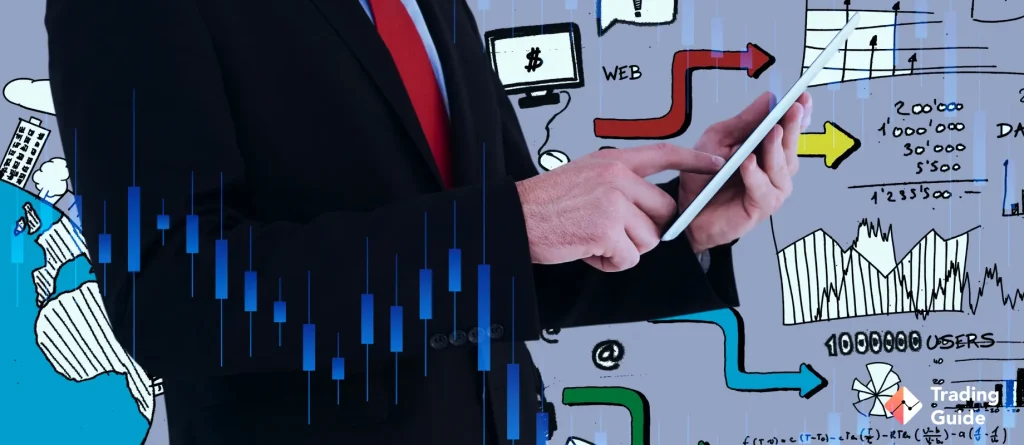Financial markets can feel confusing, especially for UK investors who are just starting out. Company results and economic news might explain long-term trends, but they often don’t make sense of quick price changes. This is where technical analysis can help.
Instead of looking at profits or forecasts, technical analysis focuses on price movement. It uses charts, trading volumes, and past behaviour to help investors understand how the market is reacting right now.
For beginners, it’s a simple way to read what the market is doing. It can help you decide when to buy or sell, or just spot patterns as they unfold, without getting lost in the noise.
In This Guide
Introduction To Technical Analysis
What is a Technical Analysis?

Technical analysis involves studying past price movements and trading volume to help forecast possible future trends in the market. Instead of evaluating a company’s fundamentals, like earnings reports or economic forecasts, it focuses solely on what the market is doing right now, as reflected in price action.
The approach is built on three core principles:
- Market prices reflect all known information. From earnings announcements to political events, every factor that could influence a security’s value is already embedded in its current price.
- Prices tend to move in trends. Market movements are rarely random. They often follow discernible patterns, whether upward, downward, or sideways, that can persist for a period of time.
- History often repeats itself. Market participants react in familiar ways, especially under pressure. As a result, patterns that played out in the past may reappear under similar conditions.
These principles form the foundation of technical tools such as candlestick charts, trendlines, support and resistance zones, and momentum indicators. Traders use them not to predict with certainty but to assess probabilities and make more informed decisions in real time.
How Technical Analysis is Used in Trading

For UK investors, technical analysis is a simple and useful way to make informed trading decisions. It’s used in many markets, including FTSE 100 shares, foreign exchange, and even cryptocurrencies.
Instead of guessing when to buy or sell, traders look for patterns in how prices move. If a stock often bounces at the same price level, that may suggest strong support and a chance to buy. Certain chart shapes, such as candlestick patterns, can indicate that a price trend is shifting. Indicators like the Relative Strength Index (RSI) can indicate whether an asset is overbought or oversold. Past price levels also help set targets or stop-loss points.
Short-term traders often use these tools to make fast decisions. But even long-term investors may use charts to choose the right moment to act. The aim isn’t to predict the future but to improve the chances of making a smart move.
Like a weather forecast, technical analysis shows likely outcomes, not certainties. It helps you see patterns more clearly and react with more control.
Technical Analysis Indicators
Technical analysis offers a wide range of tools, but new traders don’t need to learn them all at once. A few core indicators can go a long way in helping you read the market with more clarity. Each one serves a different purpose; some help identify trends, while others reveal momentum or potential turning points.
A moving average calculates the typical price of an asset over a chosen time period. It reduces noise from daily fluctuations, helping traders notice overall trends more easily. If the price stays above its 50-day average, it might suggest the asset is in an upward trend. A drop below that line could point to a change in direction.
RSI is a momentum-based tool that scores from 0 to 100. It helps identify when a stock may be rising or falling too quickly. Values above 70 often signal that the asset could be overbought, while readings below 30 may indicate it’s oversold and due for a rebound.
The MACD is a trend-following indicator that uses two moving averages, a fast one and a slow one. When the fast line crosses above the slow line, it can signal a possible buying opportunity. A cross below may suggest weakness or the start of a downtrend.
These bands expand and contract based on market volatility. They consist of a moving average in the middle, with an upper and lower band set two standard deviations away. If the price hits the upper band, the market may be overstretched. If it touches the lower band, the asset might be trading at a discount.
Support is a price level where buyers have historically stepped in, preventing further decline. Resistance occurs when sellers tend to take profits, slowing the upward movement. These levels often act like barriers, and observing how prices behave around them can improve your timing.
Volume shows how many shares or contracts are being traded. When volume rises alongside price movement, it often signals stronger conviction. For example, a price breaking through a resistance level on high volume carries more weight than the same move on low volume.
These indicators are most effective when used together, not in isolation. For instance, a stock bouncing off a support level with rising volume and a low RSI reading might present a stronger case for a potential rebound than any one signal alone. Combining tools helps filter out noise and builds a clearer picture of market behaviour.
Fundamental Analysis vs Technical Analysis

Many UK investors wonder whether they should use fundamental or technical analysis. The truth is, both methods can work well together and often lead to stronger, more confident investment decisions.
Fundamental analysis looks at what a company is worth based on its financial health. This includes things like earnings, debt, profit margins, and the state of the wider economy. For example, if you want to know whether Tesco shares are a good value for long-term growth, you’d look at its profits and dividends. That’s fundamental analysis.
Technical analysis takes a different view. It doesn’t look at how well the company is doing. Instead, it focuses on how the price is moving. A technical trader might spot a price pattern in Tesco shares that often comes before a big rise, even if the latest results haven’t changed.
Many smart investors use both. They use fundamental analysis to find strong companies, then apply technical analysis to choose when to buy or sell. This way, they get the bigger picture along with better timing. It’s a strategy that adds both insight and discipline to a trading plan.
Using both methods can help investors make more balanced decisions. It means you’re not just thinking about what a company should be worth but also paying attention to how the market is behaving right now. This dual approach is especially helpful in fast-moving or uncertain conditions.
Read about the Elliot Wave Rules to catch tops and bottoms in the market.

FAQ
The most commonly used tools include moving averages, RSI, MACD, Bollinger Bands, and volume indicators. These help traders assess trends, momentum, and market sentiment.
Trend analysis is the practice of identifying the direction of market movement, upwards, downwards or sideways. Traders use trendlines, moving averages, and price patterns to align their trades with the prevailing trend rather than going against it.
Yes, though it’s more commonly used for short-term decisions. Long-term investors may use it to improve entry points, manage risk, or identify exit strategies during broader market cycles.
Overcomplicating things, relying on too many indicators, and ignoring volume are typical missteps. Another trap is treating technical analysis as gospel rather than a probability-based framework.
Yes, many platforms allow for algorithmic strategies based on technical rules. However, automation doesn’t guarantee success and still requires human oversight, especially during volatile conditions.
Start with a few core tools that suit your goals. If you’re focused on trends, moving averages and RSI are good entry points. Over time, you can test and refine based on what adds value to your analysis.
Absolutely. While some institutions lean more on fundamental models, many professional traders, including those in hedge funds and proprietary firms, use technical tools to guide market timing, manage risk, and confirm setups.
Expert Opinion
Technical analysis blends structure with intuition. For many traders, it offers a way to navigate uncertainty by identifying familiar patterns in how markets behave. While it doesn’t guarantee outcomes, it introduces a disciplined framework that helps investors make sense of fast-changing conditions.
That sense of structure is especially useful for beginners. It creates a clearer view of what’s happening in the market, cutting through the daily noise. Whether you’re reviewing charts after work or building a watchlist of UK stocks, technical analysis gives you a visual language to interpret price movement. And like any language, fluency comes with time and repetition.





As someone who's dabbled in trading, I find it refreshing that this guide acknowledges the reality that "every indicator will fail at some point" - too many technical analysis resources oversell the precision when it's really more art than science.